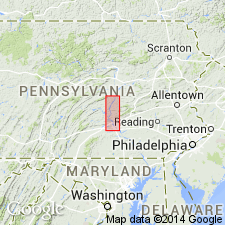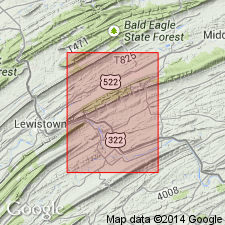
- Usage in publication:
-
- Lost Run conglomerate
- Modifications:
-
- Named
- Dominant lithology:
-
- Conglomerate
- AAPG geologic province:
-
- Appalachian basin
Summary:
Named the Lost Run conglomerate for Lost Run northeast of Lewistown, Mifflin Co., central PA. Consists of conglomerate with pebbles of vein quartz, quartz-veined quartzite, chert and jasper, and rarely, quartz-veined meta-argillite. Traced eastward from Lewistown, the ridge-making member of the Bald Eagle sandstone becomes the Lost Run conglomerate. Thickness is 350 feet in Lost Run area. Overlies the Bald Eagle sandstone and underlies the Juniata red beds. The Lost Run is of Late Ordovician age.
Source: GNU records (USGS DDS-6; Reston GNULEX).

- Usage in publication:
-
- Lost Run member
- Modifications:
-
- Revised
- AAPG geologic province:
-
- Appalachian basin
Summary:
Revised the Lost Run as the Lost Run member of the Bald Eagle formation. Unit overlies and underlies unnamed units of the Bald Eagle.
Source: GNU records (USGS DDS-6; Reston GNULEX).
For more information, please contact Nancy Stamm, Geologic Names Committee Secretary.
Asterisk (*) indicates published by U.S. Geological Survey authors.
"No current usage" (†) implies that a name has been abandoned or has fallen into disuse. Former usage and, if known, replacement name given in parentheses ( ).
Slash (/) indicates name conflicts with nomenclatural guidelines (CSN, 1933; ACSN, 1961, 1970; NACSN, 1983, 2005, 2021). May be explained within brackets ([ ]).

